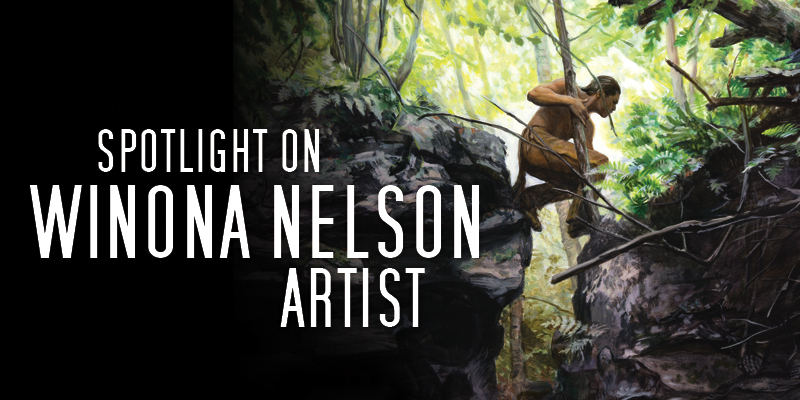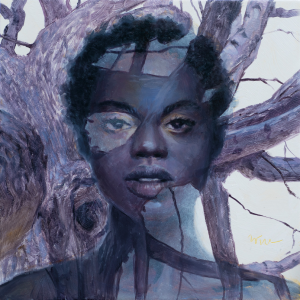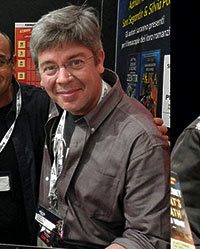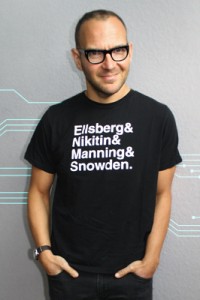Spotlight on Winona Nelson

 Artist/writer Winona Nelson was born in 1983 and grew up in Duluth MN. She has drawn all her life and began painting digitally as a teenager. She studied classical realism and art for the entertainment industry at the Safehouse Atelier in San Francisco.
Artist/writer Winona Nelson was born in 1983 and grew up in Duluth MN. She has drawn all her life and began painting digitally as a teenager. She studied classical realism and art for the entertainment industry at the Safehouse Atelier in San Francisco.
Winona is a queer, Two Spirit Indigenous person, and her fine art often focuses on the stories and history of her tribe, the Ojibwe of Minnesota, and on gender and diversity.
She now freelances full time, working in illustration, concept art, comics, fine art, children’s books, and worldbuilding/IP development. Clients include Marvel Studios, Naughty Dog, Wizards of the Coast, Simon and Schuster, Penguin Random House, and Scholastic Books. She teaches concept art and illustration for SmArt School.
Winona illustrated If You Lived During the Plimoth Thanksgiving by Christopher Newell (named one of the School Library Journal’s Best Books of 2021 and received starred reviews in the School Library Journal and Kirkus) and If You Sailed on the Titanic by Denise Patrick Lewis for Scholastic Books. Past publications include DC: Women of Action, Women of Wonder, Spectrum 17, Spectrum 18, Spectrum 19, Spectrum 20, Spectrum 23, Spectrum 24, Gorilla Artbook, Exotique 2, and Exotique 4.
Winona has participated in gallery exhibitions in Connecticut, Seattle, Los Angeles, Philadelphia, and New York City.
She lives in Pennsylvania with artist beau Anthony Palumbo and their gentleman cats, Diego and Tod.
 What was your introduction to working in the field of science fiction and fantasy art? What were the influences that drew you in?
What was your introduction to working in the field of science fiction and fantasy art? What were the influences that drew you in?
I loved video games! Final Fantasy VII was the moment I looked at the art in the booklet and realized it was drawn by a person! As a job, for money! It was done in colored pencil, which was what I primarily used at that age (I was 13 when it came out) so I could go wild imagining getting to draw characters as a job. Akira was another huge influence, and when I found out there was a graphic novel I started collecting the Dark Horse editions as they came out, asking relatives for them as holiday and birthday gifts. Looking back, I feel that the fact that these were stories of Japanese origin, and the main characters were not all white men or were androgynous looking, there was a little more room left for someone who looked and felt like me to project myself into these universes. You can still see a lot of Katsuhiro Otomo in my comics drawing style.
What does your ideal art project look like, if you had all the time in the world, and could work on anything you wanted to?
I am already working on my ideal project, a punk rock horror-comedy graphic novel called Cut Flowers, about a gender-questioning ghost who finds out she can haunt and possess her rock and roll idol. It’s going to be around 300 pages when finished, and since I am both author and artist it’s going to take years, but the first chapter is fully finished. I’m also writing a comic for my husband Anthony Palumbo to draw, another one about musicians but this time a retro-furturist scifi rom-com. If I had all the time in the world I would work on my own comics full time. (I’m currently querying agents and publishers, wink wink.)
 In your bio you mention your art is influenced by the stories and history of the Ojibwe, and that your work also focuses on gender and diversity. Can you talk a bit about how those influences play out in your work?
In your bio you mention your art is influenced by the stories and history of the Ojibwe, and that your work also focuses on gender and diversity. Can you talk a bit about how those influences play out in your work?
Growing up, there weren’t many Indigenous or queer characters in the kinds of empowering stories I wanted to read. I’ve always wanted to change that, to write and paint people who look and feel like me but who get to be heroes or multidimensional characters, rather than only tragic figures. I feel a kinship with others who aren’t as often represented in pop culture or who are reduced to stereotypes and negative depictions. I was told when I was young that painting queer people and people of color would make clients ‘‘uncomfortable’’ and would pigeonhole me, but that’s turned out to have been untrue. Clients seek me out because of the diversity visible in my portfolio.
Is there one thing you wish you could have learned early on about making art or working as a commercial artist, from someone who was experienced in the field, that you would like to share with other artists?
I am a teacher in addition to being a working artist, and the advice I give my students is to double down on the things that make you different. Conforming to the field might help you get some work in the short term, but by making your work look like others’, you make yourself interchangeable with them as well. That’s a bad career plan – far better to be sought specifically for your unique perspective, taste, and subject matter. Be your own weird self!
Interview design by Stephen H. Segal, art by Winona Nelson.
Read more in the December and January 2023 issue of Locus.
 While you are here, please take a moment to support Locus with a one-time or recurring donation. We rely on reader donations to keep the magazine and site going, and would like to keep the site paywall free, but WE NEED YOUR FINANCIAL SUPPORT to continue quality coverage of the science fiction and fantasy field.
While you are here, please take a moment to support Locus with a one-time or recurring donation. We rely on reader donations to keep the magazine and site going, and would like to keep the site paywall free, but WE NEED YOUR FINANCIAL SUPPORT to continue quality coverage of the science fiction and fantasy field.
©Locus Magazine. Copyrighted material may not be republished without permission of LSFF.







